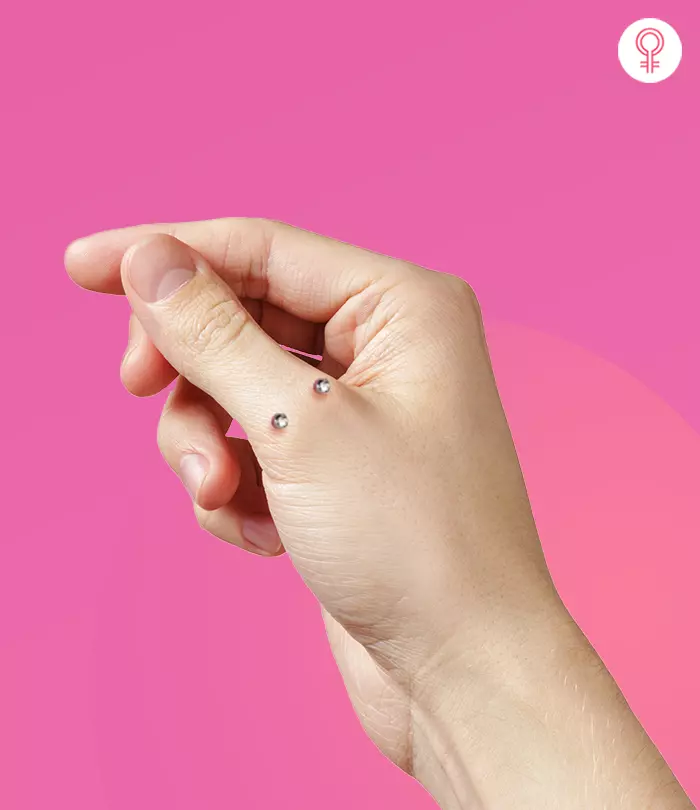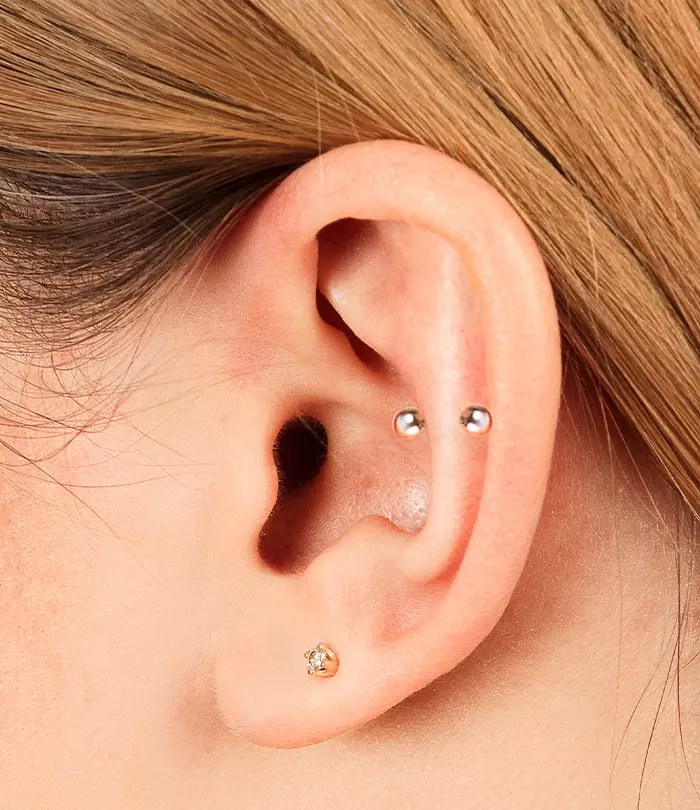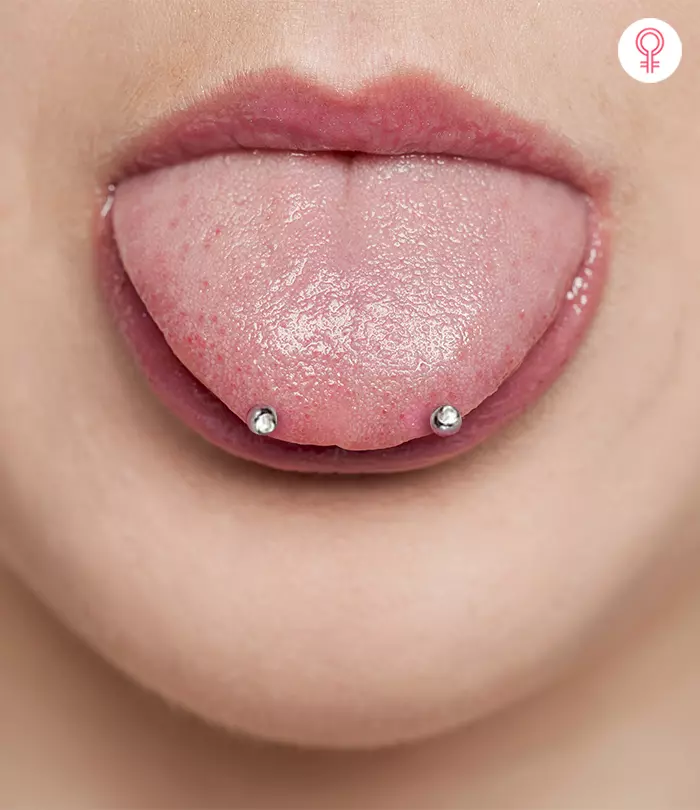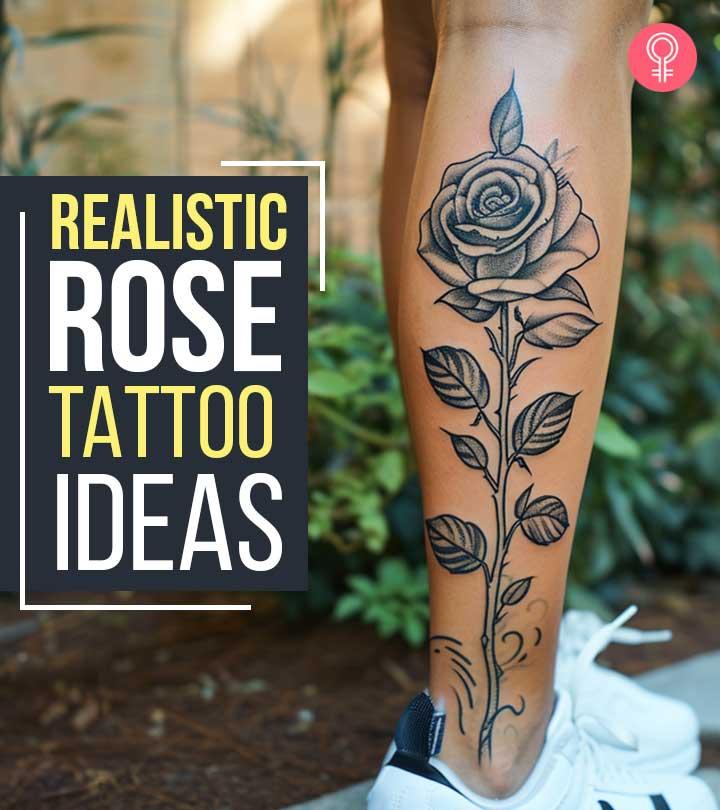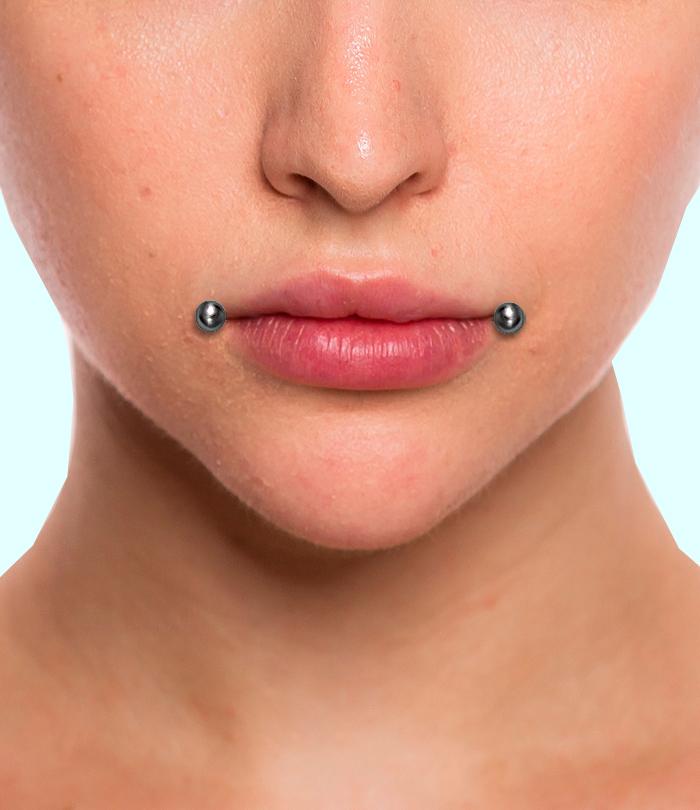Nape Piercing: Pain Level, Healing, Risks, And Jewelry
Adorn your nape with more than a necklace by getting a shiny piercing!

Image: Shutterstock
Unconventional body modifications are all the rage, and a nape piercing is no different. This piercing involves getting an inch-long piercing at the back or nape of your neck, creating an alluring adornment that hides away, unlike traditional piercings, which are often more visible. There are several types of nape piercings, with some done on the skin’s surface and others done on a microdermal level. Whether you are drawn to its subtle allure or bold aesthetic, this piercing makes for a captivating addition to your body. It makes a distinct statement about your unique identity and fashion-forward sensibilities. Keep reading to learn everything there is to know about nape piercings, from their procedure and pain level to the healing process and aftercare tips. Scroll down for more!
 Piercing Guide: Nape Piercing
Piercing Guide: Nape Piercing- Placement: Back of the neck
- Best Jewelry: Surface bars, captive bead rings
- Cost: $30 to $80
- Pain Level: Medium
- Healing Time: 2 to 4 months
In This Article
Benefits Of Getting A Nape Piercing
Discover the compelling benefits of getting a nape piercing. from its elegant style to easy maintenance. This section outlines why this subtle yet striking body modification may just be the perfect addition to your look.
- Subtle Elegance: Enjoy the elegance of a discreet neck piercing that adds a touch of sophistication to your appearance.
- Versatile Jewelry Options: Explore a wide range of jewelry designs, from delicate studs to statement pieces, to suit your style.
- Pain Management: Experience minimal pain during the piercing process due to the relatively thin skin at the nape of the neck.
- Discreet: Conceal your neck piercing effortlessly under your hair, allowing you to maintain a professional appearance when desired.
- Low Maintenance: With proper care, nape piercings heal relatively quickly and require minimal upkeep.
 Trivia
TriviaGetting a nape piercing will help boost your confidence without it being over the top and, as mentioned above, is a less painful procedure. Take a closer look at the procedure involved in getting it done.
What Is The Procedure For A Nape Piercing?
The piercing procedure for this type of piercing is fairly simple and similar to the rest.
- Prepare for your nape piercing procedure by consulting a professional piercer, skilled in this specific type of body modification.
- On the day of your appointment, your piercer will cleanse the area and mark the precise location for the piercing.
- Then, using a sterilized needle or dermal punch, they will create two separate holes in the nape of your neck.
- Next, your chosen jewelry will be carefully inserted into the freshly pierced area.
- Finally, the piercer will cleanse the area and provide detailed aftercare guidelines to promote proper healing.
There are several types of nape piercings, such as surface and microdermal. For a microdermal nape piercing, a hole is created at the back of the neck and adorned with anchor jewelry. Jasmine, a blogger, shares her experience of getting microdermal nape piercing. She writes, “I went for a microdermal because, as I said, they are more permanent and (I thought) had less chance of your body rejecting it (i).” She continues, “ It was PAINFUL and the pain lasts a while. However, as soon as the anchor was inserted, the pain went straight away and was hardly sore while it healed.”
Be sure to schedule a follow-up appointment with your piercer to ensure the piercing is healing properly and address any concerns you may have. If you are scared about the pain you may experience, keep reading.
What Is The Pain Level Of A Nape Piercing?
You may experience some discomfort, like a quick sharp pinch, during your nape surface piercing procedure, as the skin in this area is relatively thin. However, the pain level varies from person to person and is generally manageable. After the initial sharp pinch during the procedure, you may feel some soreness or tenderness in the area for a few days. You can take over-the-counter pain relievers and apply a cold compress to help alleviate any discomfort.
Remember to carefully follow your piercer’s aftercare instructions to minimize pain and promote proper healing. Healing time, like every other piercing, varies from person to person, but it may take some months.
What Is The Healing Time For A Nape Piercing?
A nape piercing typically takes about 6-12 weeks to fully heal, although individual healing times may vary. Initially, you may experience some redness, swelling, and tenderness around the piercing site, which is normal. As the healing progresses, these symptoms should gradually subside. If you notice any signs of infection or have concerns about the healing process, do not hesitate to contact your piercer for guidance.
In the initial couple of months, when your skin is healing, it is essential to follow your piercer’s aftercare instructions diligently. This promotes proper healing and minimizes the risk of complications.
Aftercare Tips For A Nape Piercing
Proper aftercare is key to ensuring a smooth healing process and maintaining the health of your new piercing (1), (2):
- Clean The Area Twice Daily: Gently cleanse your nape piercing with a sterile saline solution or mild, fragrance-free soap and warm water. Pat the area dry with a clean paper towel or cotton balls after cleaning to avoid introducing bacteria.
- Rotate Jewelry: While cleaning, carefully rotate the jewelry to prevent the buildup of crust and debris around the piercing site. Do not try to rotate the jewelry when the piercing is dry.
- Avoid Harsh Products: Steer clear of harsh products like alcohol or hydrogen peroxide, as they can irritate the piercing and delay healing.
- Do Not Submerge: Refrain from submerging your piercing in bodies of water like swimming pools, hot tubs, or lakes until it is fully healed to reduce the risk of bacterial infection.
- Wear Loose Clothing: Opt for loose-fitting clothing around the piercing site to minimize friction and irritation.
- Avoid Sleeping On The Piercing: Sleeping on your piercing can cause discomfort and hinder the healing process, so try to avoid it whenever possible.
Following proper aftercare is the key to avoiding any complications that may affect your nape piercing. What are these complications? Find out more in the next section.
Risks Of A Nape Piercing
View this post on Instagram
It is crucial to understand the potential risks involved in getting a nape piercing, from the risk of an infection to rejection. This section highlights key risks you should be aware of before getting a nape piercing.
- Infection: As with most piercings, there is a risk of infection (3). The piercing is an open wound that is vulnerable to bacterial infections. Keep the area clean and follow proper aftercare to minimize this risk.
- Rejection: Nape piercing rejection chances are higher compared to other piercings due to the constant movement and tension in the area. Be mindful of any signs of migration or rejection, such as the jewelry shifting or the skin thinning around the piercing site.
- Scarring: Improper aftercare or trauma to the piercing site can lead to scarring and lead to the formation of keloids (4). They are large and painful scars that form over the piercing site. Avoid excessive touching or playing with the jewelry to reduce the likelihood of scarring.
- Nerve Damage: There’s a risk of nerve damage during the piercing process, which can result in numbness or altered sensation in the surrounding area. Choose an experienced piercer to minimize this risk (4).
- Allergic Reactions: Some individuals may experience allergic reactions to certain jewelry materials, such as nickel or brass. Opt for hypoallergenic materials like titanium or surgical steel to reduce the risk of allergic reactions.
Being on the lookout for all these risk factors will definitely help in the proper healing of your new nape piercing. One factor that may impact how soon your piercing heals is the jewelry you adorn it with. Choosing low-quality jewelry may lead to allergic reactions and complications. Read on to know which type of jewelry and the various styles you can choose from.
Best Jewelry For A Nape Piercing
View this post on Instagram
If you have sensitive skin, it is best to use good quality jewelry made of hypoallergenic materials that do not trigger allergic reactions. It is recommended to use jewelry made from high-quality material such as titanium, gold, surgical stainless steel, niobium, and biocompatible polymers (2), (5). The most commonly used materials from the lot are:
- Titanium: It is known for its durability and hypoallergenic properties and is an excellent choice for nape piercing jewelry, minimizing the risk of irritation.
- Surgical Steel: It offers durability and affordability, making it a popular choice for nape piercing jewelry.
- Gold: It adds a touch of luxury and shine. Make sure it is high-quality 12-14 karat gold to prevent reactions.
When choosing jewelry for your nape piercing, consider options that are both stylish and comfortable. For new nape piercings, the following jewelry is the best choice:
- Surface Barbells: These sleek jewelry pieces are ideal for nape piercings, as they fit snugly against the neck’s shape.
- Captive Bead Rings: Classic and versatile, captive bead rings feature a removable bead that adds a touch of style while allowing for easy cleaning.
- Surface Bars: Specifically designed for surface piercings like neck piercings, surface bars provide stability and reduce the chances of rejection.
 Did You Know?
Did You Know?It is best to choose jewelry that complements your style while prioritizing comfort and safety for your nape piercing. After the piercing heals completely, you can easily switch out your jewelry and wear whatever you like, but there is a right way to go about it.
How To Change Out A Nape Piercing?
Knowing how to safely switch your nape piercing jewelry will help you prevent any infection or migration that may affect the way it looks. Follow the steps mentioned below for a safe piercing experience.
- Gather The Supplies: Set aside your new jewelry, clean gloves, and a mirror for better visibility. This makes the process seamless and quick.
- Wash Your Hands: Prioritize hygiene by thoroughly washing your hands with soap and warm water.
Remove Existing Jewelry: Gently unscrew or unclasp the current jewelry, being careful not to tug or force it. - Clean The Piercing: Use a saline solution to clean the piercing area, removing any debris or buildup.
- Insert New Jewelry: Carefully insert the new jewelry into the piercing, ensuring it is securely fastened.
- Check For Comfort: Confirm that the jewelry feels comfortable and secure in its placement.
- Wash Hands Again: Afterward, wash your hands once more to maintain cleanliness.
- Monitor Healing: Keep an eye on the piercing for any signs of irritation or infection as it continues to heal.
Changing the nape piercing jewelry is simple and easy, but you have to ensure hygiene to avoid any complications. Now that you are aware of everything about nape piercings, it is time to see how much it may weigh on your wallet.
Cost Of A Nape Piercing
View this post on Instagram
When considering the cost of a nape piercing, several factors come into play. The price typically includes the cost of the initial piercing procedure that can range from $30 to $80 or more, depending on the piercer’s experience and location.
Choosing an experienced piercer will cost more, but is worth it. An amateur piercer may use low-quality jewelry that comprises the health of your pierced skin. Additionally they may not have enough experience to complete the piercing process without any hitches. A skilled piercer has years of experience that make the process comfortable for you. Also, they may charge more due to their busy schedules. Choosing a reputed piercing studio can also cost more. But consider that they follow the highest hygienic standards and safety regulations to ensure your satisfaction.
Another factor that can influence the cost of a nape piercing is buying aftercare products from the piercer or studio directly. If you want to use a numbing cream or gel during the procedure, it may also affect the price.
Additionally, the type and quality of jewelry you choose will affect the overall cost. Basic jewelry options may start at around $10, while more intricate or high-quality pieces can range from $20 to $100 or more. Keep in mind that prices may vary based on the piercer’s rates and the specific jewelry options available. Be sure to inquire about all potential costs upfront to ensure there are no surprises.
A nape piercing is a unique and bold form of self-expression. Each step of the piercing journey, from the initial consultation to the careful aftercare, requires attention and care to ensure a successful outcome. Despite the potential risks and high costs involved, many find the allure of a nape piercing irresistible, drawn to its discreet yet striking appearance that adds panache to one’s personal style. But, as with any body modification, it is essential to carefully consider the risks involved before making the decision to get this piercing. With proper preparation and guidance from a professional piercer, a nape piercing can be a rewarding and empowering addition to your body modification journey.
Frequently Asked Questions
How long does a nape piercing last?
A nape piercing can last indefinitely with proper care and maintenance. However, individual healing times and factors such as lifestyle and jewelry quality can affect its longevity.
Do nape piercings grow out?
Yes, nape piercings can grow out over time due to factors such as the body’s natural healing process, excess movement, and tension in the area, and improper piercing placement.
Are there any lifestyle adjustments needed with a nape piercing?
Yes, lifestyle adjustments may be needed with a nape piercing. Avoid sleeping on the piercing, minimize friction from clothing, and refrain from activities that could put strain on the piercing site until it heals properly.
What should I consider before getting a nape piercing?
Before getting a nape piercing, consider factors such as your anatomy and lifestyle, the potential for movement and tension in the area, and the importance of proper aftercare for healing.
Key Takeaways
- Nape piercings are uncommon, but safer than most other body piercing types as it is a simple type of surface piercing.
- Consult a professional body piercing artist to avoid any mistakes that may happen during the procedure which may affect the outcome.
- They are discreet and heal in 6-12 weeks. The piercing itself feels like a sharp pain that subsides eventually.
- Barbells and surface bars are the best jewelry options while getting a nap piercing.
Nape piercings look really good and are extremely easy to get. However, like all other types of piercings, it also has its pros and cons. The video below discusses them in detail, along with other tips and tricks. Click play to learn more!
Personal Experience: Source
StyleCraze's articles are interwoven with authentic personal narratives that provide depth and resonance to our content. Below are the sources of the personal accounts referenced in this article.
i. Nape Piercinghttps://diaryofawimpygurl.wordpress.com/2014/03/16/nape-piercing/
References
Articles on StyleCraze are backed by verified information from peer-reviewed and academic research papers, reputed organizations, research institutions, and medical associations to ensure accuracy and relevance. Read our editorial policy to learn more.
- Tattooing And Body Piercing Guidance Toolkit
https://www.aad.org/public/everyday-care/skin-care-basics/tattoos/caring-for-pierced-ears - Body Piercing
https://youngwomenshealth.org/guides/body-piercing/ - Endocarditis And Meningitis Associated To Nape Piercing In A Young Female: A Case Report
https://pubmed.ncbi.nlm.nih.gov/26397300/ - Body Piercing Complications And Prevention Of Health Risks
https://www.researchgate.net/publication/297305338_Body_Piercing_Complications_and_Prevention_of_Health_Risks - Jewelry For Initial Piercings
https://safepiercing.org/wp-content/uploads/2020/05/APP_Initial_Print.pdf
Read full bio of Anjali Sayee
Read full bio of Pahul Nanra






